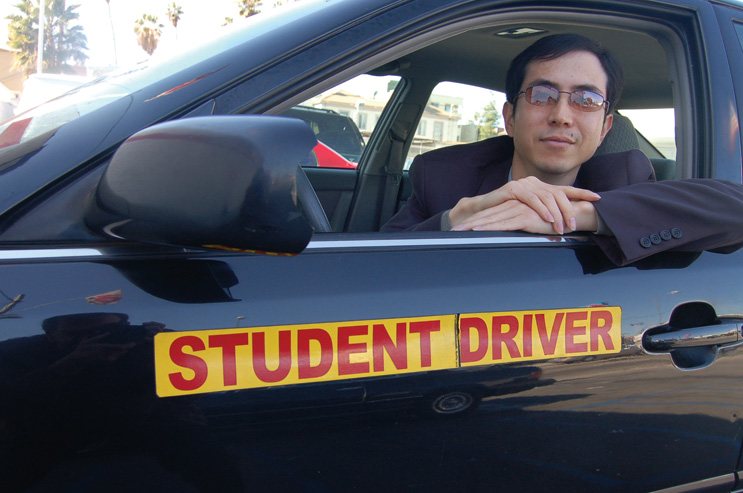by Bill Stephens
Driving instructor Joseph Kim’s first student of the day never drove in Korea, but needs a crash course, so to speak, for her new L.A. life.
“Let’s go,” the 63-year-old Kim says calmly, his eyes looking in all directions. Kim, owner of Eden Driving School, came to the U.S. in 1986, and has been a driving instructor for nine years.
As the young woman prepares to pull onto a residential street northwest of Koreatown, I re-check my backseat safety belt and reassure myself Kim has dual brakes and a gas pedal.
The student creeps along, makes bumpy stops, and turns with Kim’s hand on the wheel. We practice steering, turning, stopping. At a left turn, an SUV barrels towards us. My heart skips a beat. But with Kim’s help, the student turns safely. After a break, we’re ready to practice signal light turns in Koreatown.
At 6th and Harvard, we make a slow left turn. Behind us, a honking young male driver zooms past and yells profanities.
Kim ignores the rude driver.
“Let’s go.”
***
Weeks before I cringed in Joseph Kim’s backseat, I’d set out to understand Koreans who teach other Koreans to drive in congested Southern California.
I found there are some 75 Korean driving instructors and a few dozen Korean driving schools in Southern California. The instructors I met are educated middle-aged Korean immigrants — family men with a fondness for Toyota Corollas. Most teach part-time, as independent instructors or for schools. Some see it as temporary work, others enjoy it. A few approach the job like a mission. In fact, several are pastors.
Pastor Jay Lee meets me for coffee across from Koreatown’s Vija Driving & Traffic School, where he works 20 hours a week. At 39, he’s an assistant pastor at a Korean church. Lee, who immigrated in 1980, loves literature and writes poetry.
“So, why teach driving?” I ask.
“It’s a good job for a pastor,” says Lee, noting the flexible hours and extra income.
Korean driving schools are said to hire pastors because many are patient and communicate well. Lee says Korean women trust pastors. “If students trust you, teaching’s easier. I’m patient and enjoy teaching. It’s my gift.”
Before a lesson, Pastor Lee prays with his students for safety and a successful session. He sometimes also dispenses advice on personal matters. “Some ask me personal or spiritual questions. To listen and comfort is important. While some driving instructors are strictly businesslike, I treat my students to coffee. Human relations are important to Koreans.”
“How long will you teach driving?” I ask.
“Maybe another 10 years, until I become a senior pastor.”
***
Vija Driving & Traffic School owner Seong Un Joe is known to Radio Korea listeners as “Dr. Driving.” Every morning the 48-year-old gives listeners driving tips. After finishing college in Korea, Joe came to L.A. in 1983 to further his education. But he needed a job to support his growing family, so he went to work as a driving instructor in 1986.
“Teaching driving isn’t easy,” says Joe, who is friendly but intense.
“There’s stress and some danger. You must be patient, plus [be able to] work with different personalities and experience levels.”
At the other end of Koreatown is Vija’s competitor, Kim’s Driving School, run by 67-year-old Emanuel Kim, who also hosts a car radio talk show.
In an office cheerfully cluttered with car art, nature posters and photos of himself hiking, fast-moving Kim tells me he came to America in 1969 for graduate studies. Instead, he became the first Korean American driving instructor. That was in 1973. Since then, he’s taught some 40,000 Koreans to drive, plus 66 Korean driving instructors — all college graduates. “Driving instructor’s a good job for people with high education from Korea, who can’t find a job in their field in L.A.,” he says.
“Good, college-educated driving instructors are harder to find now,” he says, noting that recent Korean immigrants aren’t as attracted to the job because of the pay and perceived danger.
The job still appeals to Koreans who want part-time or flexible hours, don’t need a large income and enjoy teaching, he says. “Your value can increase with age, especially if you’re in good shape.” Income varies, but some dedicated independent instructors can do well, earning more than $4,000 a month.
“I like driving teachers in their 50s who are patient, people-oriented communicators,” Kim says. “If you shout, students don’t come back. You should be encouraging, not critical.”
He advises instructors to be kind and says the best teachers give a running commentary while students drive.
Kim says he wants to continue teaching because it’s his way of helping keep Koreans safe.
It is perhaps even more meaningful a job for instructor Ueon Bak.
The physically fit, 64-year-old from Orange County has been teaching driving for 24 years. Eyes moist, Bak says he became a driving instructor after his 19-year-old daughter was killed in an auto accident. He wants to teach young people safe driving.
“When I tell some of my teenage students why I teach, they’re moved. I tell them: ‘Don’t make your parents sad like me.’”
Bak says his teaching style is strict and that he’s adamant about defensive driving.
“Learning to drive is serious and driving’s like combat. Because many drivers out there are rude, self-centered, hot-tempered predators.”
Bak plans to stay with his job until he’s 80. “It’s not relaxing and my heart beats fast. But keeping children alive and their parents happy is a mission for me.”
***
Many of Southern California’s Korean driving instructors know each other. And each one carries with them a slew of stories.
Emanuel Kim says he’s had other cars intentionally bump his students from behind or throw stones. “I don’t use the ‘student driver’ sign now,” he says.
When drivers honk and yell at instructor Steve Yi, he replies, “Training. You were like that, too. Sorry.”
Seong Un Joe will never forget the time he took a nervous older female student onto the 10 freeway. When they reached 50 mph, she fainted. Joe took quick action to take control of the car. Another time, he was teaching a husband and wife. The wife had no experience, while the husband had driven in Korea. During his wife’s lessons, the husband constantly interfered. Later, the wife passed and the husband failed.
Once, Steve Hwang was teaching a man who’d driven in Korea. He didn’t listen and often asked: “Why do I have to do that?”
“I’m the teacher and you’re the student,” Steve responded. “The student is supposed to respect the teacher. Why spend the money if you don’t listen?”
The man grew red in the face and then smiled: “OK. You’re the general.”
When the man eventually passed, he took Hwang to dinner and revealed he had been a marine colonel in Korea.
Smile Driving & Traffic School instructor Henry Kim recalls the time he told a student to take a right. The student turned right — onto the sidewalk. He also remembers the only student he ever gave up on, after 30 lessons. “I saw her later at a bus stop.”
Some stories reveal driving instructor foibles. At the end of a long day, one teacher took a student onto the westbound 10 Freeway. He dozed off and awoke in Oxnard, an hour northwest.
“Why didn’t you wake me?” he asked.
The student replied, “I didn’t know you were asleep.”
***
After my final interview, in Torrance, driving instructor Eung Yin Kim, invites me to watch him teach. The 59-year-old Kim has taught driving for 30 years, mostly from his comfortable home office. Today his lesson is a dress rehearsal for a student about to take her driving test at the Torrance DMV in one hour. He calmly directs her along streets she will soon drive with the DMV examiner.
Later, at the crowded DMV, after his student drives off in Kim’s white Toyota Corolla with the examiner, Kim waits. He says teaching driving is a hard job, but he enjoys it — especially when students pass. He thinks students from Korea are better these days.
When the Corolla pulls back into the DMV parking lot, Kim tries to see if his student is smiling or frowning. Suddenly, a pedestrian starts to step off the curb in front of the car. “Stop!” Kim says. “Stop! Stop! Stop!”
The student doesn’t yield, and the pedestrian steps back onto the curb. No harm, but Kim says the mistake could mean failure. He watches as the examiner talks with her.
Then the examiner pops out and smiles. “She’s okay. She passed. Just tell her to watch for people.”
Kim breathes a sigh of relief.
After he lectures his student, they both smile. She’s says, “I have a good teacher.”





